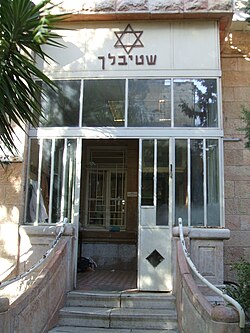This article needs additional citations for verification. (May 2017) |
A shtiebel (Yiddish: שטיבל, romanized: shtibl, lit. 'little room or house', pl. שטיבעלעך shtibelekh) is a place used for communal Jewish prayer. In contrast to a formal synagogue, a shtiebel is far smaller and approached more casually. It is typically as small as a room in a private home or a place of business that is set aside for the express purpose of prayer, or it may be as large as a small-sized synagogue. It may or may not offer the communal services of a synagogue.

Shtiebels traditionally served as places for prayer and community gatherings, often centered around a prominent Hasidic rebbe. They hosted the seudah shlishit, the ritual third meal of Shabbat, and attracted newcomers with their inviting atmosphere for prayer, eating, drinking, and community activities.[1]
Shtiebels were common in Jewish communities in Eastern Europe before the Holocaust. The shtiebel was distinctly characteristic of Hasidic Judaism and played a central and critical role in the life of the Hasidic community.[1] Shtiebels continue to exist in contemporary Israel and the United States.
The shtiebel was cost-effective, helping to spread Hasidism through a grassroots movement that enabled those familiar with it to establish local communities. This allowed Hasidism to reach more areas throughout the 18th and 19th centuries.[1]
In Israel, minyans are held in storefront shtiebelekh in major business areas around the clock; whenever ten individuals show up, a new minyan begins. The Zichron Moshe shtiebel in the Zikhron Moshe neighborhood of Jerusalem (near Geula) is located in a proper synagogue, with many rooms for round-the-clock minyans. This shtiebel is well known as the locale of Friday-night mussar talks that Rabbi Sholom Schwadron, the "Maggid of Jerusalem," delivered for more than 40 years.
Shtiblach in its current meaning
editIn the ultra-Orthodox community in Israel, synagogues developed in which several rooms (shtibelekh) were concentrated on prayer minyanim. The purpose of the shtibelekh is to allow a parallel prayer place and a more liberated atmosphere. Unlike a synagogue with regular prayer times, certain seating arrangements, and the like, the shtibelekh operates at all hours of the day and routinely includes temporary worshipers.